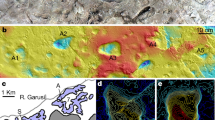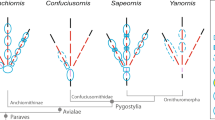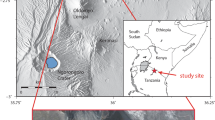Abstract
Dinosaur footprints have been used extensively as biostratigraphic markers, environmental indicators, measures of faunal diversity and evidence of group behaviour1,2,3,4,. Trackways have also been used to estimate locomotor posture, gait and speed6,7,8,9,10,11, but most prints, being shallow impressions of a foot's plantar surface, provide little evidence of the details of limb excursion. Here we describe Late Triassic trackways from East Greenland, made by theropods walking on substrates of different consistency and sinking to variable depths, that preserve three-dimensional records of foot movement. Triassic theropod prints share many features with those of ground-dwelling birds, but also demonstrate significant functional differences in position of the hallux (digit I), foot posture and hindlimb excursion.
This is a preview of subscription content, access via your institution
Access options
Subscribe to this journal
Receive 51 print issues and online access
$199.00 per year
only $3.90 per issue
Buy this article
- Purchase on Springer Link
- Instant access to full article PDF
Prices may be subject to local taxes which are calculated during checkout



Similar content being viewed by others
References
Hitchcock, E. Ichnology of New England: A Report on the Sandstone of the Connecticut Valley, especially its Fossil Footmarks, made to the Government of the Commonwealth of Massachusetts (W. White, Boston, (1858).
Lull, R. S. Triassic life of the Connecticut Valley. Conn. State Geol. Nat. Hist. Surv. Bull. 81, 1–336 (1953).
Gillette, D. D. & Lockley, M. G. eds Dinosaur Tracks and Traces (Cambridge University Press, Cambridge, (1989).
Thulborn, T. Dinosaur Tracks (Chapman and Hall, London, (1990).
Lockley, M. G. Tracking Dinosaurs: A New Look at an Ancient World (Cambridge University Press, Cambridge, (1991).
Alexander, R. McN. Estimates of speeds of dinosaurs. Nature 261, 129–130 (1976).
Coombs, W. P. J Swimming ability of carnivorous dinosaurs. Science 207, 1198–1200 (1980).
Farlow, J. O. Estimates of dinosaur speeds from a new trackway site in Texas. Nature 294, 747–748 (1981).
Thulborn, R. A. Speeds and gaits of dinosaurs. Palaeogeogr. Palaeoclimatol. Palaeoecol. 38, 227–256 (1982).
Thulborn, R. A. & Wade, M. Dinosaur trackways in the Winton Formation (mid-Cretaceous) of Queensland. Mem. Qd. Mus. 21, 413–517 (1984).
Padian, K. & Olsen, P. E. in Dinosaur Tracks and Traces (eds Gillette, D. D. & Lockley, M. G.) 231–241 (Cambridge University Press, Cambridge, (1989).
Jenkins, F. A. J et al. Late Triassic continental vertebrates and depositional environments of the Fleming Fjord Formation, Jameson Land, East Greenland. Meddr. Grønland Geoscience 32, 1–25 (1994).
Clemmensen, L. B., Kent, D. V. & Jenkins, F. A. J ALate Triassic lake system in East Greenland: facies, depositional cycles and palaeoclimate. Palaeogeogr. Palaeoclimatol. Palaeoecol. 140, 135–159 (1998).
Lull, R. S. Fossil footprints of the Jura-Trias of North America. Mem. Bos. Soc. Nat. Hist. 1904, 461–557 (1904).
Olsen, P. E. & Galton, P. M. Areview of the reptile and amphibian assemblages from the Stormberg of southern Africa, with special emphasis on the footprints and the age of the Stormberg. Palaeont. Afr. 25, 87–110 (1984).
Olsen, P. E., Smith, J. B. & McDonald, N. G. Type material of the type species of the classic theropod footprint genera Eubrontes, Anchisauripus, and Grallator (Early Jurassic, Hartford and Deerfield Basins, Connecticut and Massachusetts, U.S.A.). J. Vert. Paleo. 18, 586–601 (1998).
Baird, D. Triassic reptile footprint faunules from Milford, New Jersey. Bull. Mus. Comp. Zool. 117, 449–520 (1957).
Sereno, P. C., Forster, C. A., Rogers, R. R. & Monetta, A. M. Primitive dinosaur skeleton from Argentina and the early evolution of Dinosauria. Nature 361, 64–66 (1993).
Novas, F. E. New information on the systematics and postcranial skeleton of Herrerasaurus ischigualastensis (Theropoda: Herrerasauridae) from the Ischigualasto Formation (Upper Triassic) of Argentina. J. Vert. Paleo. 13, 400–423 (1993).
Colbert, E. H. The Triassic dinosaur Coelophysis. Mus. N. Ariz. Bull. 57, 1–160 (1989).
Raath, M. A. Anew coelurosaurian dinosaur from the Forest Sandstone of Rhodesia. Arnoldia 4, 1–25 (1969).
Sereno, P. C. & Wild, R. Procompsognathus : theropod, “thecodont” or both? J. Vert. Paleo. 12, 435–458 (1992).
Camp, C. L. Anew type of small bipedal dinosaur from the Navajo Sandstone of Arizona. Univ. Cal. Pub. Geol. Sci. 24, 39–56 (1936).
Welles, S. P. Dilophosaurus wetherilli (Dinosauria, Theropoda) osteology and comparisons. Palaeontogr. Abt. A 185, 85–180 (1984).
Nopcsa, F. On the origin of flight in birds. Proc. Zool. Soc. Lond. 1923, 463–477 (1923).
Thulborn, R. A. The avian relationships of Archaeopteryx, and the origin of birds. Zool. J. Linn. Soc. 82, 119–158 (1984).
Gauthier, J. Saurischian monophyly and the origin of birds. Mem. Calif. Acad. Sci. 8, 1–55 (1986).
Gatesy, S. M. Hind limb movements of the American alligator (Alligator mississippiensis) and postural grades. J. Zool. (Lond.) 224, 577–588 (1991).
Tarsitano, S. Stance and gait in theropod dinosaurs. Acta Palaeontol. Pol. 28, 251–264 (1983).
Gatesy, S. M. Caudofemoral musculature and the evolution of theropod locomotion. Paleobiology 16, 170–186 (1990).
Acknowledgements
We thank L. B. Clemmensen, the Danish Polar Center and the Commission for Scientific Research in Greenland for support of field work, L. L. Meszoly for rendering Fig. 1, M. A. Norell and A. R. Davidson for access to Coelophysis bauri (AMNH 7226), Alias/Wavefront for software support, and J. O. Farlow, J. R. Hutchinson, M. G. Lockley, P. E. Olsen, K. Padian, D. Norman and R. A. Thulborn for critical advice. This work was supported by grants from the National Science Foundation, the Carlsberg Foundation, and the Putnam Expeditionary Fund of Harvard University.
Author information
Authors and Affiliations
Corresponding author
Rights and permissions
About this article
Cite this article
Gatesy, S., Middleton, K., Jr, F. et al. Three-dimensional preservation of foot movements in Triassic theropod dinosaurs. Nature 399, 141–144 (1999). https://doi.org/10.1038/20167
Received:
Accepted:
Issue Date:
DOI: https://doi.org/10.1038/20167
This article is cited by
-
What do their footprints tell us? Many questions and some answers about the life of non-avian dinosaurs
Journal of Iberian Geology (2023)
-
Vertebrate ichnofauna from Sierra de las Cabras tracksite (Late Miocene, Jumilla, SE Spain). Mammalian ichnofauna
Journal of Iberian Geology (2022)
-
Examining the accuracy of trackways for predicting gait selection and speed of locomotion
Frontiers in Zoology (2020)
-
Can undertracks show higher morphologic quality than surface tracks? Remarks on large amphibian tracks from the Early Permian of France
Journal of Iberian Geology (2019)
-
The evolution of ornithischian quadrupedality
Journal of Iberian Geology (2017)
Comments
By submitting a comment you agree to abide by our Terms and Community Guidelines. If you find something abusive or that does not comply with our terms or guidelines please flag it as inappropriate.



